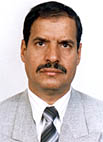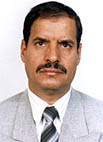
Dr. Amin Al-Hemyari: “Importing seeds and saplings without any restrictions has brought in diseased plants.” [Archives:1998/42/Interview]
October 19 1998

Many experts believe that further development of the country will depend on what happens in agriculture, livestock and fisheries – which hold great potential.
To shed light on this sector and its prospects, Ismail Al-Ghabry of Yemen Times spoke to Dr. Amin Al-Hemyari, Professor of Entomology and Dean of the College of Agriculture at Sanaa University. The American-educated Hemyari is seen by many circles as one of the serious scholars of this country. He has published numerous research papers. A man given to the details of technical matters, he is now trying to promote new skills in agricultural affairs.
Excerpts.
Q: Let us start with basic data. Give us some indicators of this sector?
A: Of course, agriculture is a shrinking sector in terms of its contribution to GDP. Total agricultural production represents about 18% of the nation’s output. That is valued at US$ 1.2 billion. The sector employs half of the nation’s labor force.
Total cropped area is about 1.2 million hectares, of which about half goes to cereal production. Fruit and vegetable production claims 20%, and qat 12%.
Translated into products, that yields about 700,000 tons of cereal – roughly a quarter of the country’s demand. Fruit and vegetable output is nearly 900,000 tons, while qat output approaches 1,000 bundles a year.
There are roughly 10 million heads of livestock. Fish output is also increasing.
Q: When was the College of Agriculture first established and how many students have graduated so far?
A: It was established by Republican Decree number 51 of 1982. The first class of students were received in 1984. The first batch – five students (just one female) – graduated in 1988.
In 1997, 153 male and 8 female students successfully completed their studies in agriculture. In the same year, 407 new students were registered. So all in all, there are now 957 graduates of the College of Agriculture. Of those, 40 are females.
Q: Why is there such a small number of agriculture students in general and female students in particular?
A: I guess there are several factors at play here. Generally speaking, and it’s quite unfortunate, people in Yemen look down on farmers and agricultural workers. Graduates of the College of Agriculture often refrain from working in the countryside, because of the lack of basic services and amenities.
With theoretical and practical work and field visits, studying in our college demands full-time devotion. As you well know many university students in Yemen are part-timers, working to earn a living in the morning and studying in the afternoon. Moreover, having a degree in agriculture doesn’t get a very financially rewarding job, if there are jobs at all in this sector.
Since it is physically demanding work, females in general refrain from studying agriculture.
Q: When was the first wholly Yemeni syllabus formulated at the college?
A: That was in 1989, relying on Arabic, European and American syllabuses. Before that the syllabus was entirely taken from Egypt.
Now, in view of the recent changes in the labor market and the demands of the development process, a full review of the curricula is in order. A special workshop on agricultural education in Yemen (17-19 October) was held with participants from the Colleges of Agriculture at the Universities of Sanaa, Aden, and Ibb. Cooperating with the Ministry of Agriculture and Irrigation, a full review of our curricula has been conducted.
The objectives of the workshop include studying and evaluating the reality of agricultural education in Yemen and proposing a plan of action for the future development of agricultural education output.
Topics discussed by the participants included the student admission policy, role of scientific research in agricultural education, role of women in agricultural education and the environment.
Q: Are environmental topics taught at the college?
A: Yes, but not enough. We’ll be giving more attention to the environment in the new proposed curricula.
Q: Are there any problems in admitting students from certain parts of Yemen?
A: There are none whatsoever. Graduates of secondary schools are admitted according to their final grades – a wholly objective criteria that we follow.
Q: Are there any non-Yemeni lecturers?
A: There are 39 Yemeni and 8 non-Yemeni teachers currently working with us.
Q: Can an average graduate of the College of Agriculture easily get a decent job in his or her field of specialty?
A: Nowadays it has become rather more difficult than before. This is, as I said, the main factor keeping students away.
Q: Where do graduates of your college usually work?
A: They are mostly employed by the Ministry of Agriculture and Irrigation, working either in its main offices or in various agricultural projects around Yemen. Others work in the cooperative and private agricultural sectors; while, a few work in fields far removed from what they studied.
Q: Are there any similarities between the subjects taught at the College of Agriculture in Sanaa and in other governorates?
A: The basic subjects in agricultural sciences are the same. Otherwise, differences follow regional variations in crops – coffee, grapes, etc – and methods of agriculture – terraces, plains – and climate variations.
Q: How do you evaluate agricultural education in Yemen?
A: Agricultural education is in need of speedy reviewing in-accordance with the requirements of the development process and the demands of the local labor market.
Q: FAO is celebrating the 53rd anniversary of its foundation. What do you have to say on this occasion?
A: Every year FAO chooses a different theme to celebrate its establishment. This year’s theme is ” Women Feed the World.” This is a very important issue in Third World countries where agricultural work is mainly done by women.
Q: Is the importation of seeds and tree saplings regulated?
A: Following the ban by the President of the Republic on importing fruits and vegetables, the private and cooperative sectors started investing in agriculture. Since most local plants are low on yield, farmers started importing improved seeds and saplings from various parts of the world. Many farmers have been quite successful in producing good-quality fruits and vegetables in commercially viable quantities.
However, many of seeds and saplings are imported without any restrictions whatsoever. This has sometimes brought in diseased plants, which did not only fail but also spread the disease to others, threatening the whole agricultural crop.
Q: The cereal production in Yemen are decreasing gradually. Why is that?
A: This is due to many reasons. The rise in qat farming comes first. Subsidized cereal production does not bring in as much money as qat. Second comes fruit and vegetable production which also provide a high financial turnover. This has made Yemen rely more and more on importing cereals.
Q: Are there any studies done in that regard?
A: Many experts visit Yemen every now and then to do research in various fields of agriculture. Unfortunately, such studies are not brought together in one place to be documented so that Yemeni researchers can benefit from them. Although there is a documentation center at the Ministry of Agriculture, its activities are still somewhat limited.
Q: What has been done to protect the rare species of plant and animal endemic on the Island of Socotra?
A: Climate variation in Yemen has led to a wide diversity in its flora and fauna, which had been neglected in the past. Lately, a lot of attention has been given by the Government, the Environmental Protection Council, the Agricultural Research Authority and Yemeni universities to preserving and sustaining the country’s bio-diversity.
The Island of Socotra is especially targeted by these efforts. The College of Agriculture at Sanaa University has established a genetic bank to preserve the original genetic data collected from various part of Yemen.
——
[archive-e:42-v:1998-y:1998-d:1998-10-19-p:./1998/iss42/intrview.htm]


